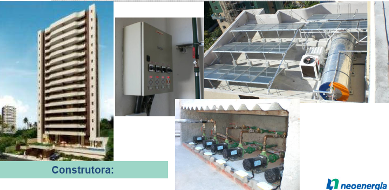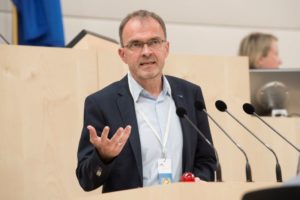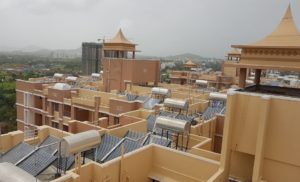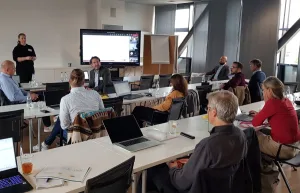

Multi-family building with solar thermal system
Brazil: Difficulties with implementing Solar Systems in Multi-family Buildings
 The picture above shows one of the seven solar thermal systems installed in multi-family houses in Bahia State and subsidised by Coelba, the state’s electric utility. Originally, Coelba intended to support a total of 20 systems, but only 7 were realised due to a lack of interest among construction companies.
The picture above shows one of the seven solar thermal systems installed in multi-family houses in Bahia State and subsidised by Coelba, the state’s electric utility. Originally, Coelba intended to support a total of 20 systems, but only 7 were realised due to a lack of interest among construction companies.
Photo: Presentation by Mariana Barreto Alfonso, Energy Efficiency Analyst at Coelba
In some Brazilian cities, installing solar heating systems in residential, multi-family buildings has just recently begun to emerge – for example in Belo Horizonte, a city in which more than 2,500 buildings possess central solar water heating systems. In the state of Bahia, the state’s own electric utility initiated a pioneering project in 2006 whose objective was to install solar heating systems in 20 residential, multi-family buildings by investing Brazilian Reais (BRL) 4 million. To achieve that goal, the utility offered interest-free loans to finance the investment costs of solar water heating systems. It was one of the measures Coelba introduced in order to fulfil the regulations of the Brazilian Electricity Regulatory Agency (ANEEL), which requires electricity distributors to invest 0.25 % of their net turnover in energy-efficiency measures.
The Bahia project named Coelba Solar was implemented in partnership with the Association of Real Estate Company Managers of Bahia (Ademi). Its results were summarized in a presentation held by Mariana Barreto Alfonso, Energy Efficiency Analyst at Coelba, during the Sustentar, the third International Forum on Sustainable Development, in June 2010 (see the attached presentation).
According to Barreto, “seven projects were completed between 2007 and 2010”. All of these buildings are being monitored, in order to determine the auxiliary heating demand for hot water generation. The energy analyst outlined the difficulties faced by the Coelba team: “The project was terminated due to a lack of interest throughout the construction sector.” Barreto thinks this was partly caused by architects not ready to incorporate solar thermal technology into the design of new buildings. In addition, the building boom contributed to the excessive increase in workload for people employed in construction companies. “This reduced their time and interest in exploiting and implementing new technologies,” Barreto argued in his presentation.
What was also influencing the Coelba Solar administrators within the utility to stop the programme was the new resolution No 300 by ANEEL, which prohibited the implementation of eligible energy-efficiency measures in new, commercial buildings. With this amendment, Coelba could only continue the programme if the solar heating systems were installed in already constructed buildings using performance contracts.
Despite its untimely end, the Coelba Solar programme gave rise to some impressive solar installations (see the attached presentation). The available monitoring systems will also provide further proof of the efficiency of solar thermal technology. The first study on the monitoring results is thought to be published later this year.
http://www.coelba.com.br/
http://www.sustentar.net/
http://www.ademi-ba.com.br/
This text was written by Carlos Faria Café, Director of SE-Studio Equinócio – Marca Solar Group based in Brazil:
http://www.studioequinocio.com.br
café@studioequinocio.com.br


